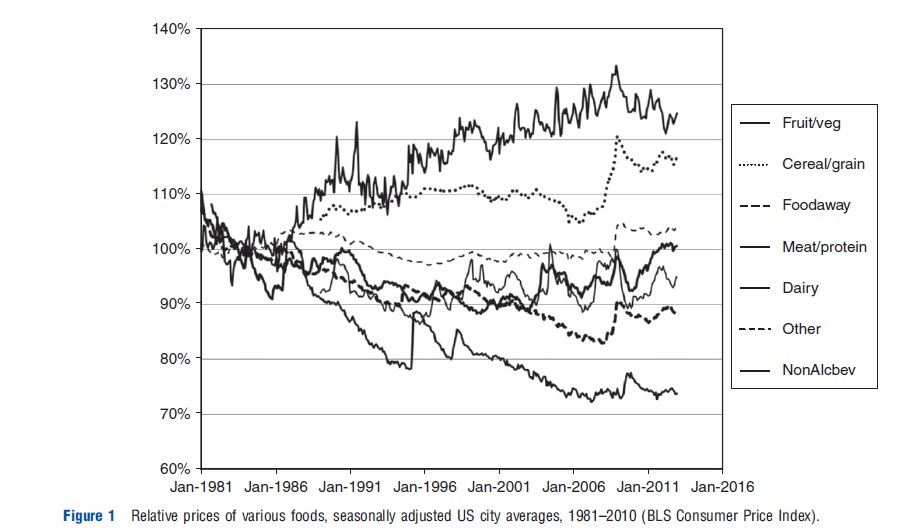The Effect Of Economic Conditions On Nutrition
As theoretical foundations, economists use both (1) a traditional simple theory of consumer choice and also (2) more elaborate theories that more specifically address health and nutrition issues.
The traditional economic theory of choice suggests that rational consumers seek to purchase a bundle of goods (x1, x2,…, xk) that satisfies their preference (represented by the utility function U) and is feasible given the budget constraint. Because the budget constraint depends on the consumer’s income (Y) and the prices of the goods (p1, p2,…, pk), the theory suggests that consumer choices respond in a systematic way to prices and incomes. Formally, the consumer solves the choice problem:
Max U(x1, x2,…, xk),
subject to p1x1+p2x2+…+pk xk≤Y
For normal goods, if income increases, then the quantity purchased increases. In standard cases, if the price increases, then the quantity purchased decreases. Goods whose consumption amounts tend to rise and fall together (such as peanut butter and jelly) are complements: if the price of a good increases, then the quantity purchased of a complementary good decreases. Other goods (such as beef and pork) are substitutes: if the price of a good increases, then the quantity purchased of a substitute good increases. The responsiveness of these price and income effects is measured using elasticities, which denote the percentage change in consumption of a food in response to a 1% increase in the explanatory variable.
In studying nutrition issues, economists have in various ways extended the simple traditional theory of choice to take account of the health consequences of food choices. Consider a consumer who must choose goods to purchase and the amount of time to spend on an array of activities (z1, z2,…, zk), including daily hours of sleep, work, watching TV, exercise, grocery shopping, and cooking. Just as there is a budget constraint for total purchases, there is also a time constraint for the total number of hours available in a day. Such extended theories of choice offer insight into nutritionally relevant decisions. For example:
- Weight change from one month to the next depends on the amount of food energy consumed and the amount of energy expended on daily activities;
- Dietary quality depends in part on how the consumer combines purchased food with time spent in activities (as when a consumer chooses between a fast-food meal and a home-cooked meal);
- The time costs of preparing food may influence consumer choices among restaurant meals, convenience food, and home-cooked meals;
- The quality and convenience of healthy food options in the local food retail environment may influence consumer food choices;
- Consumer choices about food purchases and activities may reflect preference in direct ways (as when one eats the foods one likes or does the activities one enjoys) and also indirect ways (as when one spends time in difficult physical exercise or eats less-preferred foods because of their healthiness). Recent work using household-level data from the US, France, and the UK, by Dubois et al. (in press) suggests preference may play a large role in food choice across countries in addition to the role of prices and nutrient characteristics.
The traditional theory of choice points our attention toward trends in food prices and incomes. With regard to prices, one important pattern in the United States is that the price of food has fallen relative to the price of other goods and services. A second pattern is that prices evolve differently for some food groups than for others. Using 1981 as the base time period, Figure 1 shows in subsequent months how each food group’s price increased relative to the average increase in the level of prices for all foods and beverages combined. Thus, by 2008, the price of fruits and vegetables had increased most rapidly (indexE130%), the price of food away from home had increased at the same rate as overall food and beverage average prices (indexE100%), and the price of soda and other nonalcoholic beverages had increased much more slowly than the overall average (indexE75%). These trends have raised the concern that comparatively more healthy choices have become relatively more expensive. For example, a French study found that energy dense foods like fats and oils, sugar, refined grants, and others were the cheapest (Drewnowski and Darmon, 2005).

With regard to incomes, the United States is sufficiently prosperous that food uses up less than 10% of income for most households. Yet, there remains a significant population of low-income Americans for whom the income constraint is more influential. The overall US poverty rate (share of persons in families with incomes below the official poverty line) recently increased from 11.3% in 2000 to 15.1% in 2010, which nearly equals the peak levels of 15.2% during the recession of the early-1980s. Real median household income rose only slowly from 1980 to 2000 and did not increase further after 2000.
Beyond prices and incomes, more elaborate nutritionoriented theories point our attention toward additional broad trends in recent years. Time spent preparing food has fallen as technologies have changed. At the same time, work has changed, perhaps reducing calories expended thereby. Women are increasingly in the workforce and spending less time in home production. Restaurant food and convenience food have become more important food sources.